
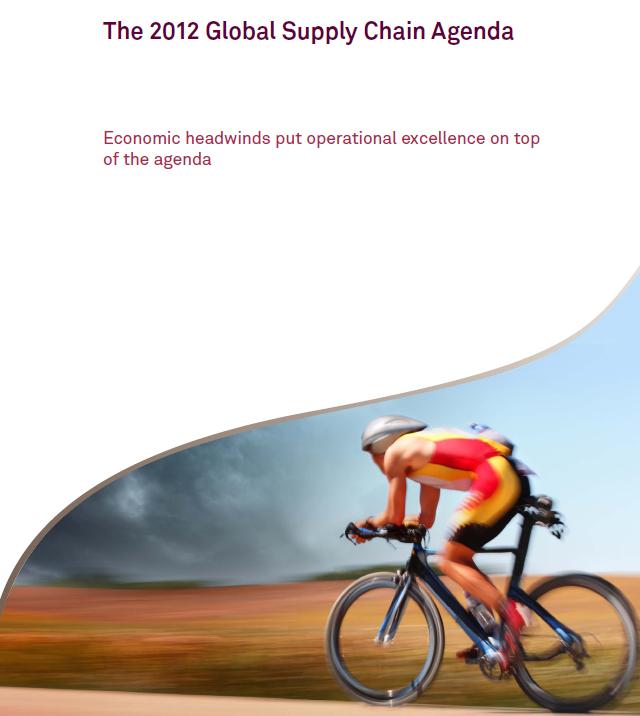
Prepared
and edited by:
- Xue
Li, Capgemini Consulting Netherlands
- Erik
Koperdraat, Capgemini Consulting Netherlands
For the 4th year in a row Capgemini Consulting is pleased to present the result of our annual international supply chain survey. The study assesses the views of supply chain executives around the world on their key priorities
|
In recent months, the world economy has dropped due to the continuing euro-zone crisis. The resulting uncertainty around the future economic situation is reflected in our 2012 supply chain survey. Specifically, market volatility (52%) was voted the number one business driver that respondents currently face. This is followed by the economic downturn (39% of the respondents). On the other hand, only 17% have an optimistic outlook and believe that economy will recover in 2012. However, when compared to the previous economic slowdown of ‘08-‘09, it appears that companies are better prepared to handle the volatility. In our current survey 52% of the respondents indicate that they are now better prepared for a more volatile environment, while the remaining indicate there are equally (43%) or even worse prepared (6%).
So what are the strategic plans for 2012? 65% of the respondents indicate that they have planned operational excellence projects. Supply chain visibility improvement (57%), and business innovation (56%) are also ranked high in the list.
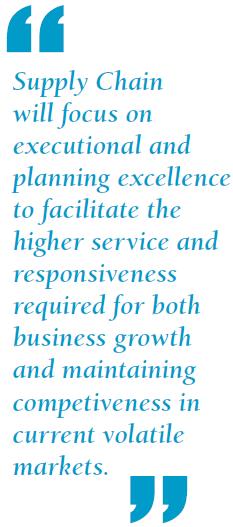
350 Supply chain professionals shared their supply chain agenda with Capgemini Consulting
In this year’s edition of Capgemini Consulting’s annual international supply chain study, 350 leading companies participated from Europe (64%), the Americas (21%), Asia-Pacific (11%) and Others (4%).
In this report we first look at the business drivers for companies in 2012. Secondly we share how companies are prepared for market uncertainty and what kind of measures they have taken to improve their supply chain flexibility. Next, we provide the list of top 10 supply chain projects as voted by our respondents and the difficulties in the project execution. We summarize the report at the end.
Volatility is the key business driver for 2012
What are the business challenges that are driving the strategic plans and project focus of our responding companies? Market/demand volatility (52%) is the most important one, closely followed by economic downturn (39%). As predicted by the IMF, Euro-zone countries will struggle to reduce the damage of the crisis and the emerging markets will slow down their development pace. Whether that will weaken US economic growth is still unclear, but it is a common understanding that 2012 will be a volatile year again.
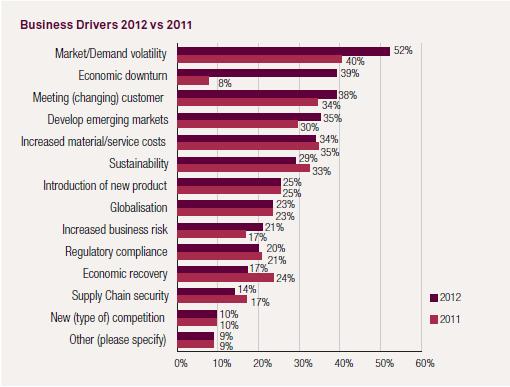
Market volatility
Market volatility has sat high on this list for two years, and probably will continue to be highly ranked in the coming year. To plan resources and production capacity accordingly on a strategic level is not going to be easy. Increased commodity and raw material prices will put an enormous pressure on procurement spend and overall profitability. Hence, operations should be supported by a smart procurement strategy and pricing mechanisms. Among all the business challenges, more demanding customers, who require better quality and more adaptive service and products, cannot be neglected. After all, the question is how well are we prepared for a gloomy economic outlook?
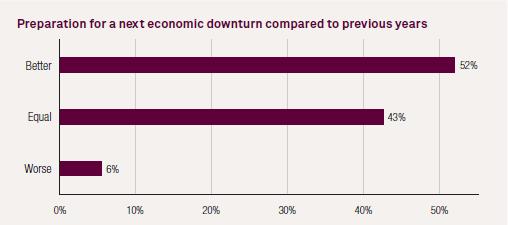
Recession preparation
The
worsened economic outlook for many of the world’s
economies is becoming an important topic for 2012.
We have asked the respondents how well they are
prepared for an economic downturn in 2012 compared
to previous years (08/09). Over half of the participants
indicate they are better prepared for an economic
downturn compared to previous years.
Furthermore we asked the respondents what kind of
measures they have taken to improve the flexibility
of their supply chains. First in the list, and mentioned
by 67% of the respondents, are measures to improve
visibility and control.
Companies that have taken these measures are expected
to have a head start in 2012, since they are able
to measure and adapt their supply chains.
Mentioned by 59% of the participants are measures to increase flexibility in operations. Examples of these measures are usage of flexible labor or space. Financial measures such as reduced capital exposure (43%) and cash flow improvements (33%) are also frequently mentioned by the participants. A reduction in capital exposure can be achieved by seller and buyer collaboration or, for example, by a reduction of working capital such as inventory reduction. Examples of cash flow improvements include improved account receivables.
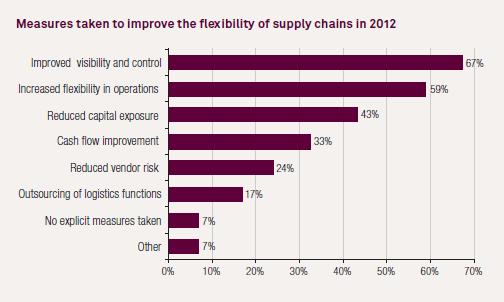
Operational Excellence and visibility projects top the supply chain agenda
In our list of the top 10 supply chain projects that companies plan on undertaking in 2012, operational excellence (65%), logistics contract renewal (60%) and visibility projects (57%) are ranked the highest. Compared to 2011 list, the votes are significant higher for all the top 10 project types. Facing a volatile market, companies have adopted different approaches. Some are implementing the traditional programs such as operational excellence, or sales and operations planning; while others are choosing innovative programs such as business innovation, or supply chain control towers. One of the big changes in the 2012 list is that sustainability projects have not made into our list in 2012. Sustainability initiatives require a solid business case to demonstrate their added value. Many companies have de-prioritized it from the cooperate agenda. Another change is the emphasis on talent programs. In the past, we often saw that there was not enough focus on developing people capabilities in the supply chain area. To establish the required competencies, such as analytic capabilities, a creative mindset, a collaborative attitude, and effective leadership, companies have taken serious efforts in putting a long term people development plan in place.
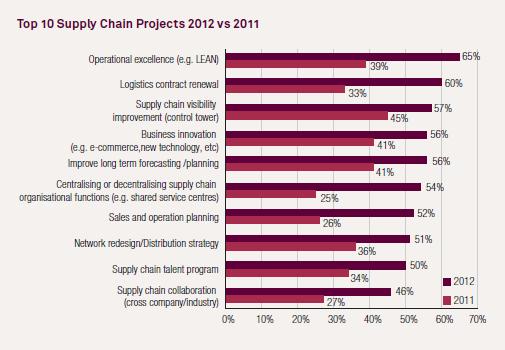
Operational excellence
Why operational excellence projects are ranked number 1 in our list? Responding companies believe that before moving to the next stage of excellence, establishing a value driven and cost effective operation must be their primary goal. Another important goal of such operational excellence initiatives is to establish a continuous improvement company culture. This is more challenging because it changes the behavior at all levels and requires top-down commitment from the whole organization. The leading companies move from pure opportunistic cost reduction programs to initiatives that can help them achieve long-lasting and sustainable business results.
Visibility
Projects for improving supply chain visibility continue to be high on the agenda of supply chain executives. Companies keep recognizing the importance of improving supply chain visibility because it enables them to measure and improve the effectiveness of the overall supply chain. With the current market volatility, there is a need for a single, consistent view of the end-to-end supply chain. This view encompasses the cross-organizational flows of materials, capital, and information. The objective of enhancing SC visibility is to capture and interconnect data, to extract information and then to apply the information to have different, and better, decision outcomes.
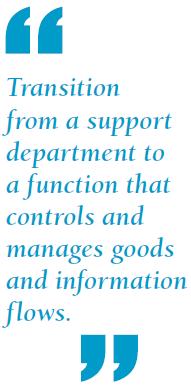 |
Difficulties in implementing projects The pessimistic economic outlook is forcing companies to re-evaluate priorities and focus on programs that will improve efficiency and save costs. 44% of the respondents indicate business prioritization will remain the main bottleneck for implementing their supply chain strategy. Financial resource challenges are mentioned by 39% of the respondents as an important bottleneck. IT capability is traditionally also within the top 3 of mentioned bottlenecks and this year is no exception. Looking ahead there are many uncertainties and companies have many priorities, which makes the task even more challenging. This forces companies to be more selective in their choice of supply chain projects and investment decisions. Another common problem is that once a company is in firefighting mode, it is very difficult for management to move into another strategic direction. Supply chain executives and top management must have a shared understating of the benefits that supply chain projects can have for the whole organization. Once there is a common understanding of the true benefits, supply chain initiatives should get a seat in the C-level meeting agenda. |
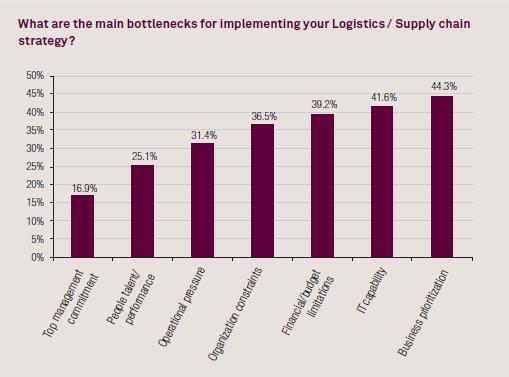 |
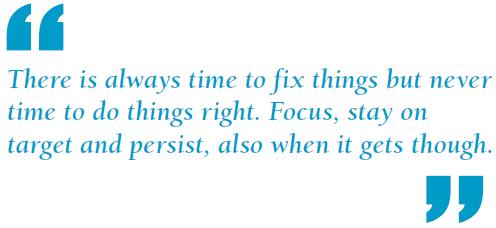 |
|
|

